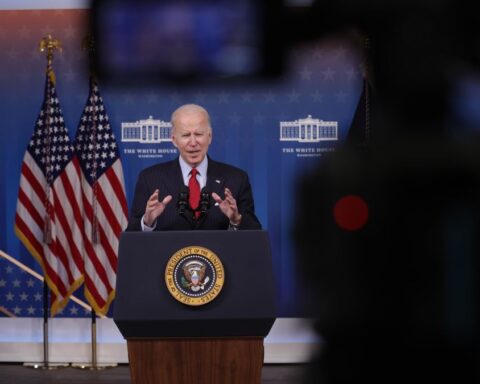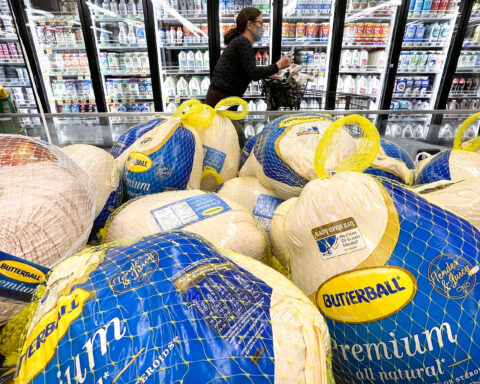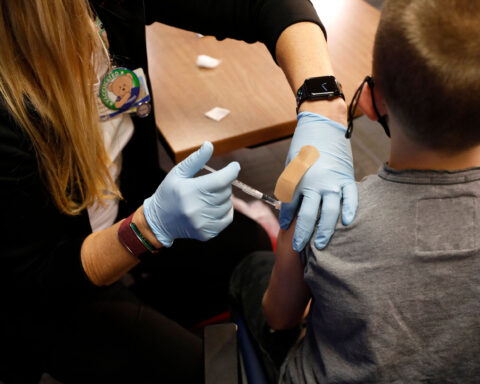We’re living through a life-changing pandemic, an assault on democracy and a reckoning with racial justice. But it’s the economy and inflation souring the overall mood for Americans.
There’s plenty of cause for concern on social, political and health issues. Covid-19 cases are up in most states, signaling yet again that the virus is here to stay. A series of court cases proved the national reckoning on issues of race is as complicated and unsolvable as ever.
And looming behind every story on politics is the expected, attempted comeback of former President Donald Trump, who this time last year was plotting a coup. Sometimes these stories dovetail, as when Trump met with Kyle Rittenhouse, the teenager who was recently acquitted after killing two people in Kenosha, Wisconsin, last summer.
On Wednesday, meanwhile, President Joe Biden pointed to the conviction of three White men in the death of Ahmaud Arbery, a 25-year-old Black man, as proof that “our justice system (is) doing its job.”
What may touch more Americans more directly every day, however, is the state of the US economy.
Here is the disconnect between the data and daily life: People are feeling the pinch due to rising costs at the gas pump and the grocery store even when there’s a lot of very good economic news to be thankful for.
First, pretty much anyone who wants a job has one. The government recorded just 199,000 new jobless claims last week, the lowest since 1969. Meanwhile, a key measure of inflation rose to a 31-year high in October.
CNN’s Christine Romans, in a video report, described this Covid-19 pandemic contradiction.
I’ve borrowed much of her language for this list of arguably good news, which includes:
- US industrial output is racing ahead above pre-pandemic levels.
- Auto manufacturing bounced back last month and factory output would have been even stronger if not for hiccups in the corporate supply chain.
- Corporate profits are enviable and big companies are navigating supply chain woes, passing along higher costs to customers and even padding their profit margins along the way.
- The biggest publicly traded companies have bigger profit margins today than before the pandemic, and your retirement account probably shows it.
- The Dow is up 17% this year and the S&P 500 is up 25%. If you step back farther since the market crashed in 2020, some averages have doubled.
- Workers have the upper hand. You’ve heard it called the “Great Resignation” — Americans quitting their jobs in record numbers. In September, 4.4 million jumped ship, and economists say many are taking better jobs with higher pay and starting bonuses.
- Paychecks are fatter after years of sluggish wage growth, especially for low-wage workers. Wage growth is nearing 5%.
- Americans are saving. Thanks to higher pay, Covid-19 stimulus checks and child tax credits, Americans have an excess $2.3 trillion in savings since the crisis began. JP Morgan says its median checking account balance is 50% higher this year than in 2019.
- The economy is adding jobs. Overall, 5.8 million jobs were added this year.
There is certainly a contradiction here if the national mood is down while the economic indicators are up.
In a recent CBS News poll, just 4% of Americans said things in the country are generally going very well, and 26% said they are going somewhat well. People felt the same way about the economy: A combined 30% said the condition of the national economy was very good or fairly good.
It’s also true that while concerns about the economy are up, they are still historically quite low, as Gallup notes.
“Inflation concerns hog all the headlines, but most other indicators are roaring ahead,” Romans said in her report.
She offered two reasons consumer sentiment gauges don’t reflect the strong indicators:
- Americans are exhausted by the pandemic.
- They are bombarded every day by higher prices at the grocery store and the gas station. “Everybody drives and eats; not everybody owns stocks,” she said.
It’s hard to square those strong indicators with the silly meme circulating in Washington that some Americans might not be able to afford turkeys this year because of inflation.
I asked Ariel Edwards-Levy, CNN’s polling editor, how to view the national mood, and she argued the polling defies easy takeaways.
She said, “It’s simultaneously true that:
- a) concerns about the economy are on the rise,
- b) the economy still isn’t nearly as dominant an issue as it was during the Great Recession,
- c) Americans’ prevailing views of the economy right now are overall pretty lousy and
- d) views of the economy are closely entangled with partisanship.”
The partisan element is an important one. Large portions of Republicans might have a worse view of the economy right now simply because of their disregard for Biden. Democrats might have exhibited the same behavior during the Trump administration.
Food is certainly more expensive. The American Farm Bureau Federation crunched numbers to argue the average Thanksgiving feast for 10 people will cost $53.31, or about $5.30 per person. Last year, its average figure was $46.90.
The American Farm Bureau Federation noted that turkeys are more expensive this year, but also added the asterisk that it shopped for turkeys to make these calculations before grocery stores had stocked for Thanksgiving.
When White House press secretary Jen Psaki was asked about this being the most expensive Thanksgiving ever, she responded, “I just want to be clear that there are abundance of turkeys available. They’re about one dollar more for a 20-pound bird, which is a huge bird if you’re feeding a very big family. And that’s something that, again, we’ve been working to make sure people have more money in their pockets to address it as the economy is turning back on.”
An abundance of turkeys is something for which every American can be thankful, even if there is concern that they cost a bit more.





